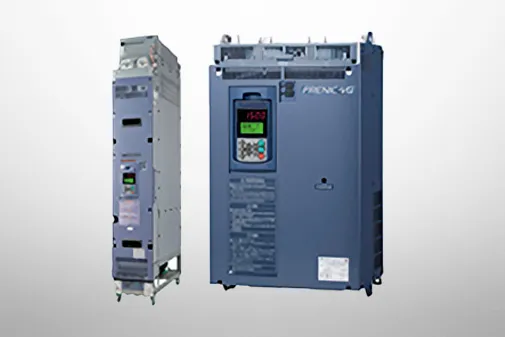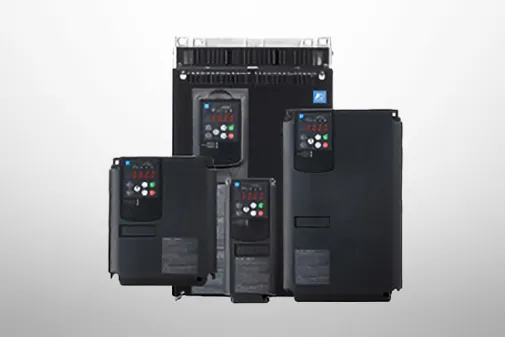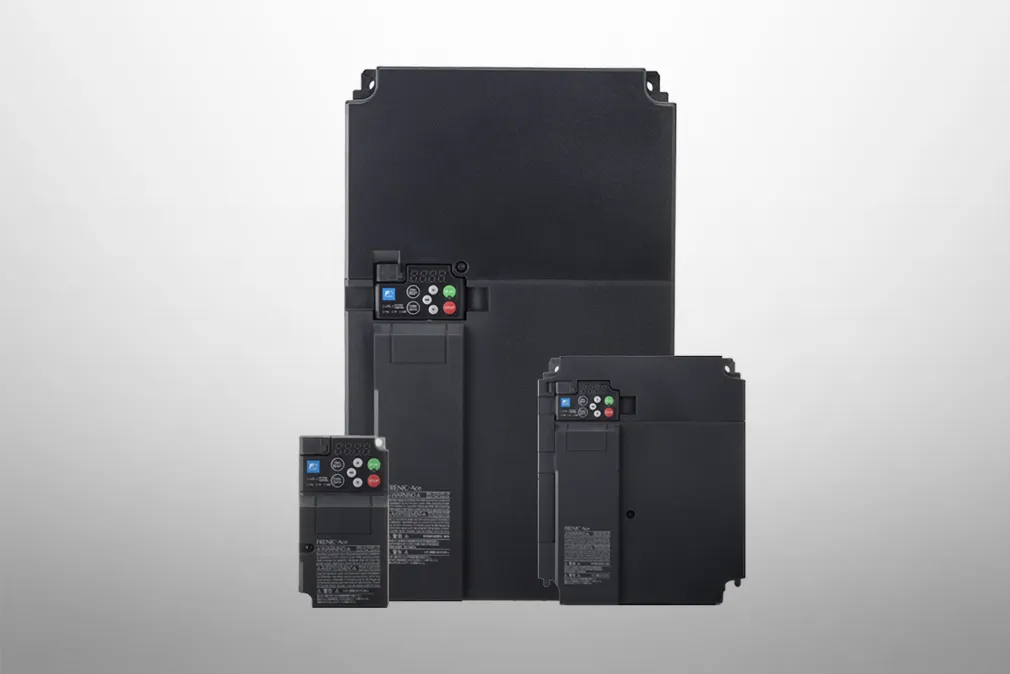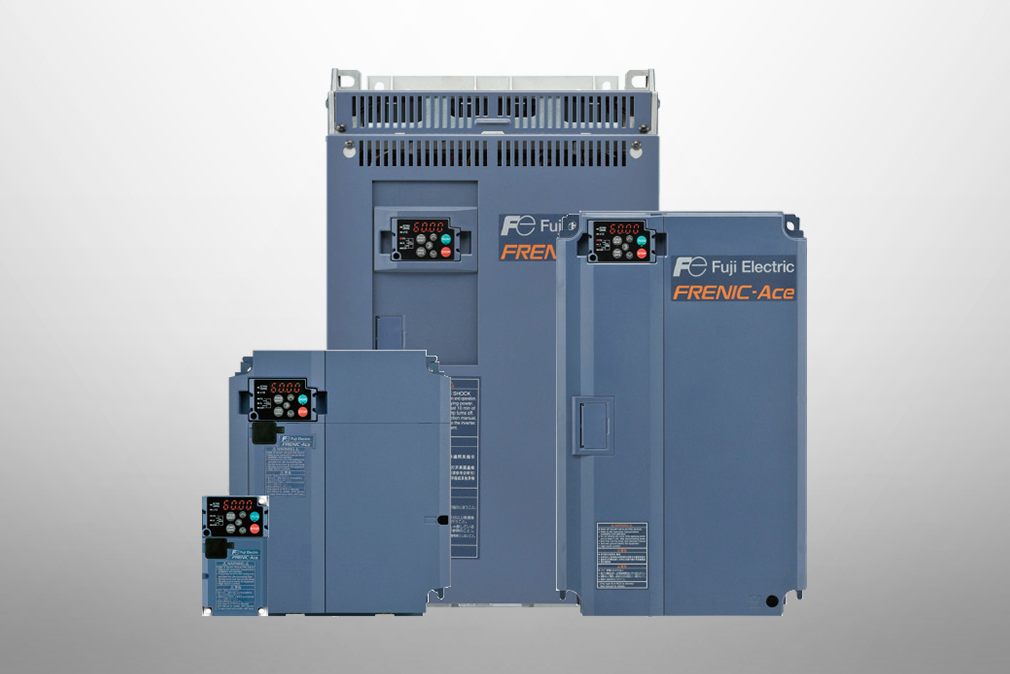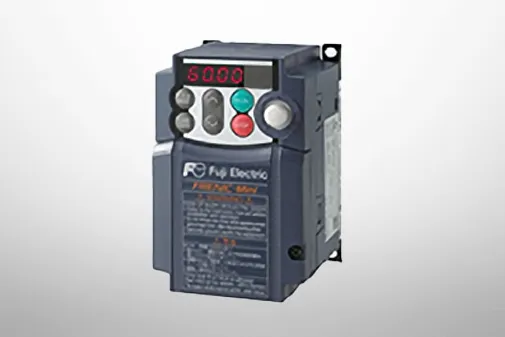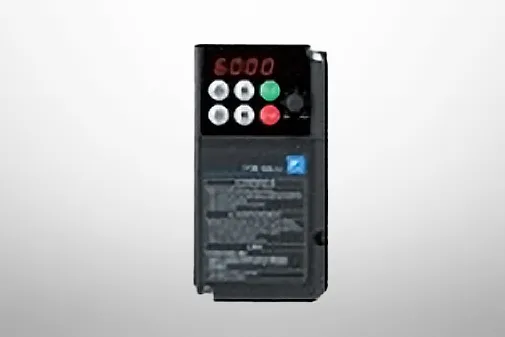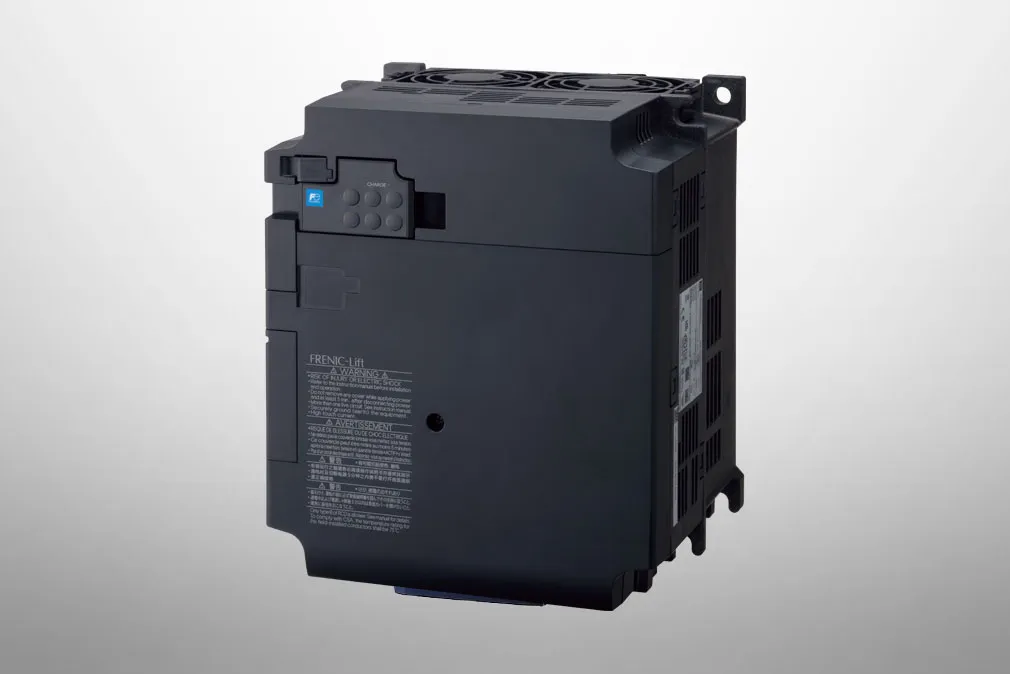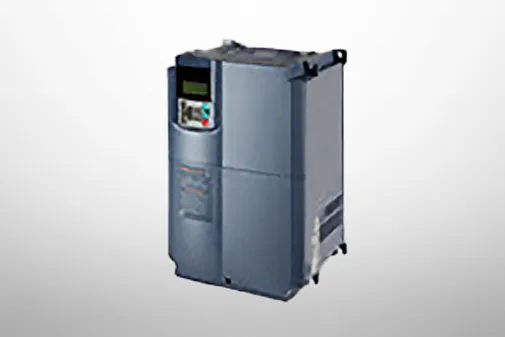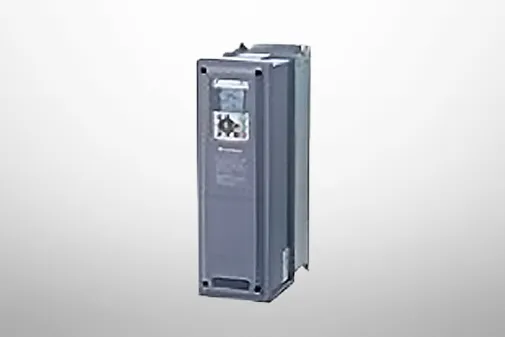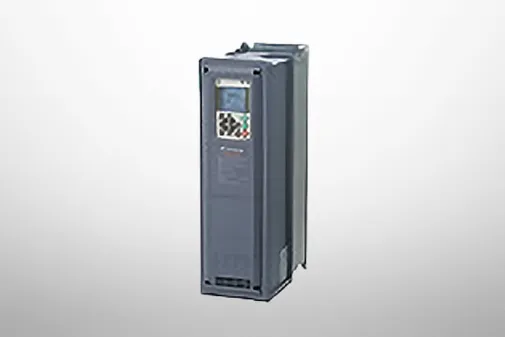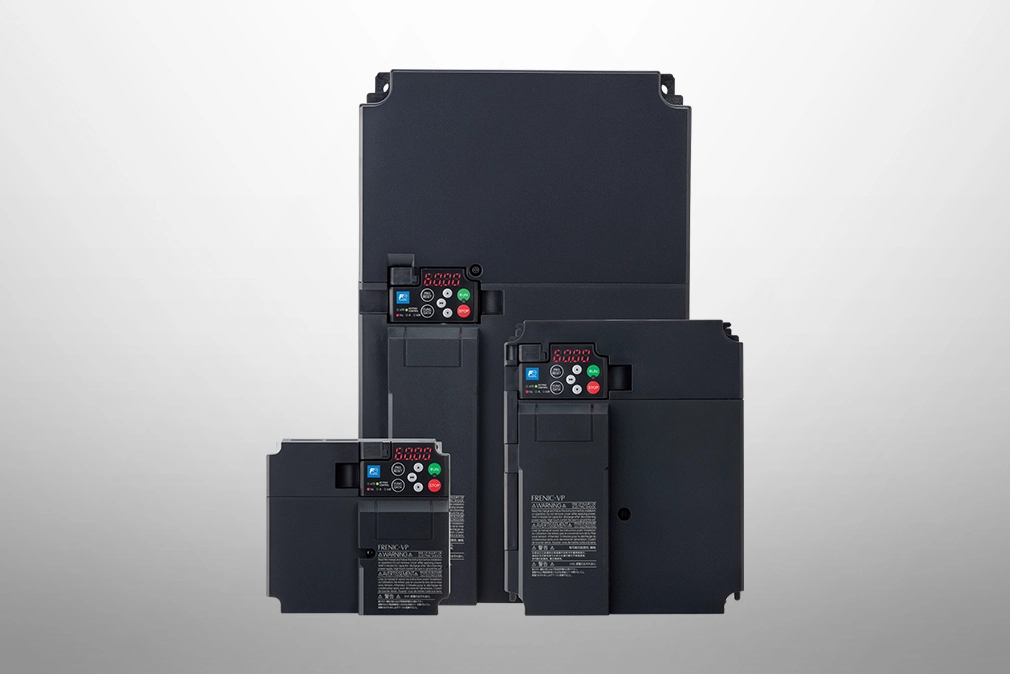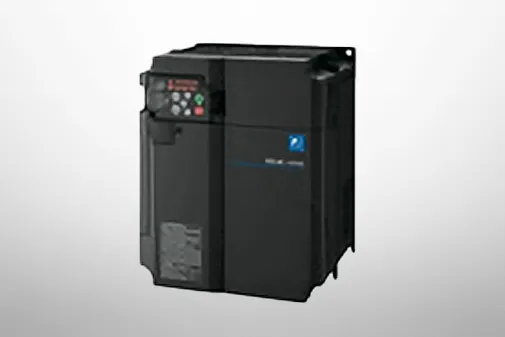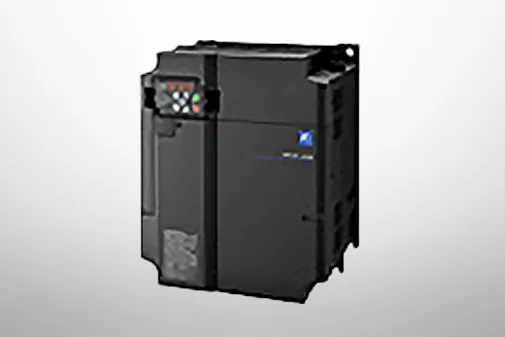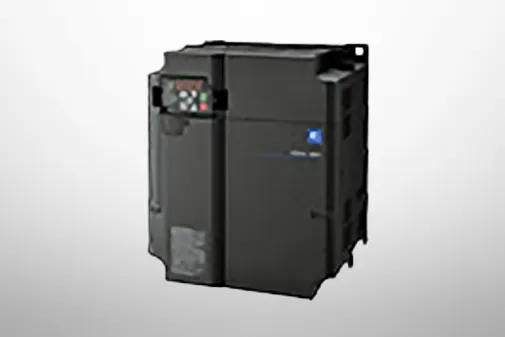Download
Alarm code
Instantaneous overcurrent
Problem:The inverter momentary output current exceeded the overcurrent level.
 Overcurrent occurred during acceleration.
Overcurrent occurred during acceleration.
 Overcurrent occurred during deceleration.
Overcurrent occurred during deceleration.
 Overcurrent occurred during running at a constant speed.
Overcurrent occurred during running at a constant speed.
Overvoltage
Problem:The DC link bus voltage was over the detection level of overvoltage.
 Overvoltage occurs during the acceleration.
Overvoltage occurs during the acceleration.
 Overvoltage occurs during the deceleration.
Overvoltage occurs during the deceleration.
 Overvoltage occurs during running at constant speed.
Overvoltage occurs during running at constant speed.
Undervoltage
Problem:DC link bus voltage has dropped below the undervoltage detection level.
| Possible Causes |
What to Check and Suggested Measures |
| (1) A momentary power failure occurred. |
→Reset the alarm.
→To restart the motor without treating this condition as an alarm, set F14 to "4" or "5," depending on the load type.
|
| (2) The power to the inverter was switched back to ON too soon (when F14 = 1). |
Check if the power to the inverter was switched back to ON while the control power was still alive. (Check whether the LEDs on the keypad light.)
→Switch the power ON again after all LEDs on the keypad go off.
|
| (3) The power supply voltage did not reach the inverter's specification range. |
Measure the input voltage.
→Increase the voltage to within the specified range.
|
| (4) Peripheral equipment for the power circuit malfunctioned, or the connection was incorrect. |
Measure the input voltage to find which peripheral equipment malfunctioned or which connection is incorrect.
→Replace any faulty peripheral equipment, or correct any incorrect connections.
|
| (5) Any other load(s) connected to the same power supply has required a large starting current, causing a temporary voltage drop. |
Measure the input voltage and check the voltage fluctuation.
→Reconsider the power system configuration.
|
| (6) Inverter's inrush current caused the power voltage drop because the power supply transformer capacity was insufficient. |
Check if the alarm occurs when a molded case circuit breaker (MCCB), residual-current-operated protective device (RCD)/earth leakage circuit breaker (ELCB) (with overcurrent protection) or magnetic contactor (MC) is turned ON.
→Reconsider the capacity of the power supply transformer.
|
Input phase loss
Problem:Input phase loss occurred, or interphase voltage unbalance rate was large.
| Possible Causes |
What to Check and Suggested Measures |
| (1) Main circuit power input wires broken. |
Measure the input voltage.
→Repair or replace the input wires.
|
| (2) Screws on the main circuit power input terminals are loose. |
Check if the screws on the inverter input terminals have become loose.
→Tighten the terminal screws to the recommended torque.
|
| (3) Interphase voltage unbalance between three phases was too large. |
Measure the input voltage.
→Connect an AC reactor (ACR) to lower the voltage unbalance between input phases.
→Raise the inverter capacity.
|
| (4) Overload cyclically occurred. |
Measure the ripple wave of the DC link bus voltage.
→If the ripple is large, raise the inverter capacity.
|
| (5) Single-phase voltage was input to the three-phase input inverter. |
Check the inverter type.
→Apply three-phase power. The FRENIC-Mini of three-phase input cannot be driven by single-phase power supply.
|
-
Note
-
The input phase loss protection can be disabled with the function code H98 (Protection/ Maintenance Function).
Output phase loss
Problem:Output phase loss occurred.
| Possible Causes |
What to Check and Suggested Measures |
| (1) Inverter output wires are broken. |
Measure the output current.
→Replace the output wires.
|
| (2) The motor winding is broken. |
Measure the output current.
→Replace the motor.
|
| (3) Screws on the main circuit power input terminals are loose. |
Check if the screws on the inverter output terminals have become loose.
→Tighten the terminal screws to the recommended torque.
|
| (4) A single-phase motor has been connected. |
→Single-phase motors cannot be used. Note that the FRENIC-Mini only drives three-phase induction motors.
|
Heat sink overheat
Problem:Temperature around the heat sink has risen abnormally.
| Possible Causes |
What to Check and Suggested Measures |
| (1) Temperature around the inverter exceeded the inverter's specification range. |
Measure the temperature around the inverter.
→Lower the temperature around the inverter (e.g., ventilate the panel where the inverter is mounted).
|
| (2) Ventilation path is blocked. |
Check if there is sufficient clearance around the inverter.
→Change the mounting place to ensure the clearance.
|
| Check if the heat sink is not clogged.
→Clean the heat sink.
|
| (3) Service life of cooling fan has expired or cooling fan is faulty. |
Check the cumulative run time of the cooling fan. Refer to Chapter 3, Section 3.4.5 "Reading maintenance information – "Maintenance Information"."
→Replace the cooling fan.
|
| Visually check whether the cooling fan rotates normally.
→Replace the cooling fan.
|
| (4) Load was too heavy. |
Measure the output current.
→Reduce the load (e.g. Use the overload early warning (E34) to reduce the load before the overload protection is activated.). (In winter, the load tends to increase.)
→Decease the motor sound (Carrier frequency) (F26).
→Enable the overload prevention control (H70).
|
External alarm
Problem:External alarm was inputted (THR).
(when THR ("Enable external alarm trip") is assigned to any of digital input terminals [X1] through [X3], [FWD], and [REV])
| Possible Causes |
What to Check and Suggested Measures |
| (1) An alarm function of external equipment was activated. |
Check the operation of external equipment.
→Remove the cause of the alarm that occurred.
|
| (2) Wrong connection or poor contact in external alarm signal wiring. |
Check if the external alarm signal wiring is correctly connected to the terminal to which the THR terminal command ("Enable external alarm trip") has been assigned (Any of E01 through E03, E98, and E99 should be set to "9.").
→Connect the external alarm signal wire correctly.
|
| (3) Incorrect setting of function code data. |
Check if the THR terminal command ("Enable external alarm trip") has been assigned to an unavailable terminal (with E01 through E03, E98, or E99).
→Correct the assignment.
|
| Check whether the normal/negative logic of the external signal matches that of the THR terminal command specified by any of E01 through E03, E98 and E99.
→Ensure the matching of the normal/negative logic.
|
Motor protection (PTC thermistor)
Problem:Temperature of the motor has risen abnormally.
| Possible Causes |
What to Check and Suggested Measures |
| (1) The temperature around the motor exceeded the motor's specification range. |
Measure the temperature around the motor.
→Lower the temperature.
|
| (2) Cooling system for the motor defective. |
Check if the cooling system of the motor is operating normally.
→Repair or replace the cooling system of the motor.
|
| (3) Load was too heavy. |
Measure the output current.
→Reduce the load (e.g. Use the overload early warning (E34) to reduce the load before the overload protection is activated.). (In winter, the load tends to increase.)
→Lower the temperature around the motor.
→Increase the motor sound (Carrier frequency) (F26).
|
| (4) The activation level (H27) of the PTC thermistor for motor overheat protection was set inadequately. |
Check the thermistor specifications and recalculate the detection voltage.
→Modify the data of function code H27.
|
| (5) Connections and resistance values of the PTC thermistor and pull-up resistor are not appropriate. |
Check the connections and the resistance value.
→Correct the connections and replace the resistor with the one having an appropriate resistance.
|
| (6) Excessive torque boost specified. (F09, A05) |
Check whether decreasing the torque boost (F09, A05) does not stall the motor.
→If no stall occurs, decrease the torque boost (F09, A05).
|
| (7) The V/f pattern did not match the motor. |
Check if the base frequency (F04, A02) and the rated voltage at base frequency (F05, A03) match the values on the motor's nameplate.
→Match the function code data to the values on the motor's nameplate.
|
| (8) Incorrect setting of function code data. |
Although no PTC thermistor is used, the thermistor mode is enabled (H26).
→Set the H26 data to "0" (Disable).
|
Charging resistor overheat
Problem:The charging resistor incorporated in the inverter has overheated.
| Possible Causes |
What to Check and Suggested Measures |
| (1) The inverter power was frequently turned ON and OFF. |
Decrease the ON/OFF frequency of the inverter power.
→Limit the ON/OFF frequency to once/hour or less.
|
| (2) The charging circuit is defective. |
Although the inverter power was not frequently turned ON and OFF, the error has occurred.
→Consult your Fuji Electric representative for repair.
|
| (3) Power applied gradually with transformer or stabilized power supply |
Turn ON the power with wiring circuit breaker or electromagnetic contactor, etc. |
Braking resistor overheated
Problem:The electronic thermal protection for the braking resistor has been activated.
| Possible Causes |
What to Check and Suggested Measures |
| (1) Braking load is too heavy. |
Reconsider the relationship between the braking load estimated and the real load.
→Lower the real braking load.
→Review the performance of the current braking resistor and increase the braking capability. (Modification of related function code data (F50 and F51) is also required.)
|
| (2) The specified deceleration time was too short. |
Recalculate the deceleration torque and time needed for the current load, based on the moment of inertia of the load and the deceleration time.
→Increase the deceleration time (F08, E11).
→Review the performance of the current braking resistor and increase the braking capability. (Modification of related function code data (F50 and F51) is also required.)
|
| (3) Incorrect setting of function code data F50 and F51. |
Recheck the specifications of the braking resistor.
→Review the data of function codes F50 and F51, then reconfigure them.
|
-
Note
-
The inverter issues an overheat alarm of the braking resistor by monitoring the magnitude of the braking load, not by measuring its surface temperature.
When the braking resistor is frequently used so as to exceed the settings made by function codes F50 and F51, therefore, the inverter issues an overheat alarm even if the surface temperature of the braking resistor does not rise. To squeeze out full performance of the braking resistor, configure function codes F50 and F51 while actually measuring the surface temperature of the braking resistor.
Motor 1 overload/Motor 2 overload
Problem:Electronic thermal protection for motor 1 or motor 2 activated.
| Possible Causes |
What to Check and Suggested Measures |
| (1) The electronic thermal characteristics do not match the motor overload characteristics. |
Check the motor characteristics.
→Reconsider the data of function codes (P99, F10 and F12) or (A39, A06 and A08).
→Use an external thermal relay.
|
| (2) Activation level for the electronic thermal protection was inadequate. |
Check the continuous allowable current of the motor.
→Reconsider and change the data of function code F11 or A07.
|
| (3) The specified acceleration/ deceleration time was too short. |
Recalculate the acceleration/deceleration torque and time needed for the current load, based on the moment of inertia of the load and the acceleration/deceleration time.
→Increase the acceleration/deceleration time (F07, F08, E10, E11).
|
| (4) Load was too heavy. |
Measure the output current.
→Reduce the load (e.g. Use the overload early warning (E34) to reduce the load before the overload protection is activated.). (In winter, the load tends to increase.)
|
Inverter overload
Problem:Temperature inside inverter has risen abnormally.
| Possible Causes |
What to Check and Suggested Measures |
| (1) Temperature around the inverter exceeded the inverter's specification range. |
Measure the temperature around the inverter.
→Lower the temperature (e.g., ventilate the panel where the inverter is mounted).
|
| (2) Excessive torque boost specified. (F09, A05) |
Check whether decreasing the torque boost (F09, A05) does not stall the motor.
→If no stall occurs, decrease the torque boost (F09, A05).
|
| (3) The specified acceleration/ deceleration time was too short. |
Recalculate the acceleration/deceleration torque and time needed for the current load, based on the moment of inertia of the load and the acceleration/deceleration time.
→Increase the acceleration/deceleration time (F07, F08, E10, E11).
|
| (4) Load was too heavy. |
Measure the output current.
→Reduce the load (e.g. Use the overload early warning (E34) to reduce the load before the overload protection is activated.). (In winter, the load tends to increase.)
→Decrease the motor sound (Carrier frequency) (F26).
→Enable overload prevention control (H70).
|
| (5) Ventilation paths are blocked. |
Check if there is sufficient clearance around the inverter.
→Ensure the clearance.
|
| Check if the heat sink is not clogged.
→Clean the heat sink.
|
| (6) Service life of cooling fan has expired or cooling fan is faulty. |
Check the cumulative run time of the cooling fan. Refer to Chapter 3, Section 3.4.5 "Reading maintenance information – "Maintenance Information"."
→Replace the cooling fan.
|
| Visually check whether the cooling fan rotates normally.
→Replace the cooling fan.
|
| (7) The wires to the motor are too long, causing a large leakage current from them. |
Measure the leakage current.
→Insert an output circuit filter (OFL).
|
Memory error
Problem:Error occurred in writing data to the inverter memory.
| Possible Causes |
What to Check and Suggested Measures |
| (1) During writing of function code data (especially during initialization or data copying), the inverter was shut down so that the voltage to the control PCB has dropped. |
Initialize the function code data with H03 (= 1). After initialization, check if pressing the  key resets the alarm. key resets the alarm.
→Revert the initialized function code data to their previous settings, then restart the operation.
|
| (2) Inverter affected by strong electrical noise when writing data (especially initializing or copying data). |
Check if appropriate noise control measures have been implemented (e.g., correct grounding and routing of control and main circuit wires). Also, perform the same check as described in (1) above.
→Implement noise control measures. Revert the initialized function code data to their previous settings, then restart the operation.
|
| (3) Any error in control circuit. |
Initialize the function code data by setting H03 to "1," then reset the alarm by pressing the  key and check that the alarm goes on. key and check that the alarm goes on.
→The control PCB (on which the CPU is mounted) is defective. Contact your Fuji Electric representative.
|
Keypad communications error
Problem:A communications error occurred between the remote keypad (option) and the inverter.
| Possible Causes |
What to Check and Suggested Measures |
| (1) Broken communications cable or poor contact. |
Check continuity of the cable, contacts and connections.
→Re-insert the connector firmly.
→Replace the cable.
|
| (2) Inverter affected by strong electrical noise. |
Check if appropriate noise control measures have been implemented (e.g., correct grounding and routing of control and main circuit wires).
→Implement noise control measures. For details, refer to the FRENIC-Mini User's Manual, "Appendix A."
|
| (3) The remote keypad (option) defective. |
Replace the keypad with another one and check whether a keypad communications error (Er2) no longer occurs.
→Replace the keypad.
|
CPU error
Problem:A CPU error (e.g. erratic CPU operation) occurred.
| Possible Causes |
What to Check and Suggested Measures |
| (1) Inverter affected by strong electrical noise. |
Check if appropriate noise control measures have been implemented (e.g. correct grounding and routing of control and main circuit wires and communications cable).
→Implement noise control measures.
|
Operation protection
Problem:An incorrect operation was attempted.
| Possible Causes |
What to Check and Suggested Measures |
(1) The  key was pressed when H96 = 1 or 3. key was pressed when H96 = 1 or 3. |
Check if the  key was pressed when a run command had been entered from the input terminal or through the communications link. key was pressed when a run command had been entered from the input terminal or through the communications link.
→If this was not intended, check the setting of H96.
|
| (2) The start check function was activated when H96 = 2 or 3. |
Check if any of the following operations has been performed with a run command being entered.
- Turning the power ON
- Resetting the alarm
- Switching the enable communications link LE operation
→Review the running sequence to avoid input of a run command when this error occurs.
If this was not intended, check the setting of H96.
(Turn the run command OFF before resetting the alarm.)
|
Tuning error
Problem:Auto-tuning failed.
| Possible Causes |
What to Check and Suggested Measures |
| (1) A phase was missing (There was a phase loss) in the connection between the inverter and the motor. |
→Properly connect the motor to the inverter.
|
| (2) V/f or the rated current of the motor was not properly set. |
Check whether the data of function codes matches the motor specifications.
Motor 1: F04, F05, H50 through H53, P02, and P03
Motor 2: A02, A03, A16, and A17 |
| (3) The wiring length between the inverter and the motor was too long. |
Check whether the wiring length between the inverter and the motor exceeds 50 m (164 ft).
→Review, and if necessary, change the layout of the inverter and the motor to shorten the connection wire. Alternatively, minimize the wiring length without changing the layout.
→Disable both auto-tuning and auto-torque boost (Set the data of F37 or A13 to "1").
|
| (4) The rated capacity of the motor was significantly different from that of the inverter. |
Check whether the rated capacity of the motor is three or more ranks lower, or two or more ranks higher than that of the inverter.
→Replace the inverter with one with an appropriate capacity.
→Manually specify the values for the motor parameters P06, P07 and P08 or A20, A21 and A22.
→Disable both auto-tuning and auto-torque boost (Set the data of F37 or A13 to "1").
|
| (5) The motor is a special type such as a high-speed motor. |
→Disable both auto-tuning and auto-torque boost (Set the data of F37 or A13 to "1").
|
| (6) A tuning operation involving motor rotation (P04 or A18 = 2) was attempted while the brake was applied to the motor. |
→Specify the tuning that does not involve the motor rotation (P04 or A18 = 1).
→Release the brake before tuning that involves the motor rotation (P04 or A18 = 2).
|
RS-485 communications error
Problem:A communications error occurred during RS-485 communication.
| Possible Causes |
What to Check and Suggested Measures |
| (1) Communications conditions of the inverter do not match that of the host equipment. |
Compare the settings of the y codes (y01 to y10) with those of the host equipment.
→Correct any mismatch.
|
| (2) Even though no-response error detection time (y08) has been set, communications is not performed within the specified cycle. |
Check the host equipment.
→Change the settings of host equipment software or disable the no-response error detection (y08 = 0).
|
| (3) The host equipment (e.g., PLCs and computers) did not operate due to incorrect settings or software/hardware defective. |
Check the host equipment.
→Remove the cause of the equipment error.
|
| (4) RS-485 converter did not operate due to incorrect connections or settings, or defective hardware. |
Check the RS-485 converter (e.g., check for poor contact).
→Change the various RS-485 converter settings, reconnect the wires, or replace hardware with recommended devices as appropriate.
|
| (5) Broken communications cable or poor contact. |
Check the continuity of the cable, contacts and connections.
→Replace the cable.
|
| (6) Inverter affected by strong electrical noise. |
Check if appropriate noise control measures have been implemented (e.g., correct grounding and routing of control and main circuit wires).
→Implement noise control measures.
→Implement noise reduction measures at the host side.
→Replace the RS-485 converter with a recommended insulated one.
|
Data saving error during undervoltage
Problem:The inverter failed to save data such as the frequency commands, PID commands, timer values for timer operation (which are specified through the keypad) or the output frequencies modified by the UP/DOWN terminal commands when the power was switched OFF.
| Possible Causes |
What to Check and Suggested Measures |
| (1) During data saving performed when the power was turned OFF, the voltage fed to the control PCB dropped in an abnormally short period due to the rapid discharge of the DC link bus. |
Check how long it takes for the DC link bus voltage to drop to the preset voltage when the power is turned OFF.
→Remove whatever is causing the rapid discharge of the DC link bus voltage. After pressing the  key and resetting the alarm, revert the data of the relevant function codes (such as the frequency commands, PID commands, timer values for timer operation (specified through the keypad) or the output frequencies modified by the UP/DOWN terminal commands) back to the original values and then restart the operation. key and resetting the alarm, revert the data of the relevant function codes (such as the frequency commands, PID commands, timer values for timer operation (specified through the keypad) or the output frequencies modified by the UP/DOWN terminal commands) back to the original values and then restart the operation.
|
| (2) Inverter affected by strong electrical noise during data saving performed when the power was turned OFF. |
Check if appropriate noise control measures have been implemented (e.g., correct grounding and routing of control and main circuit wires).
→Implement noise control measures. After pressing the  key and resetting the alarm, revert the data of the relevant function codes (such as the frequency commands, PID commands, timer values for timer operation (specified through the keypad) or the output frequencies modified by the UP/DOWN terminal commands) back to the original values and then restart the operation. key and resetting the alarm, revert the data of the relevant function codes (such as the frequency commands, PID commands, timer values for timer operation (specified through the keypad) or the output frequencies modified by the UP/DOWN terminal commands) back to the original values and then restart the operation.
|
| (3) The control circuit failed. |
Check if ErF occurs each time power is switched ON.
→The control PCB (on which the CPU is mounted) is defective. Contact your Fuji Electric representative.
|
Mock alarm
Problem:The LED displays the alarm Err.
| Possible Causes |
What to Check and Suggested Measures |
| (1) Data of the function code H45 has been set to "1." |
This setting makes the inverter issue a mock alarm. Use this to check out the sequence related to an alarm occurrence.
→To escape from this alarm state, press the  key. key.
|
PID feedback wire break
Problem:The PID feedback wire is broken.
| Possible Causes |
What to Check and Suggested Measures |
| (1) The PID feedback signal wire is broken. |
Check whether the PID feedback signal wires are connected correctly.
→Check whether the PID feedback signal wires are connected correctly. Or, tighten up the related terminal screws.
→Check whether any contact part bites the wire sheath.
|
| (2) PID feedback related circuit affected by strong electrical noise. |
Check if appropriate noise control measures have been implemented (e.g., correct grounding and routing of signal wires, communication cables, and main circuit wires).
→Improve the noise control measures.
→Separate the signal wires from main power wires as far as possible.
|
Step-out detection (for drive of permanent magnet synchronous motors)
Problem:The step-out of the PMSM was detected.
| Possible Causes |
What to Check and Suggested Measures |
| (1) Mismatch with the characteristics of the motor. |
Check whether the settings of F04, F05, P02, P03, P60, P61, P62, P63 agree with the motor parameters.
→Set the motor parameters to those function codes.
|
| (2) Starting torque was insufficient. |
Check the settings of the acceleration time (F07, E10) and the reference current at starting (P74).
→Change the acceleration time to match the load.
→Increase the reference current value at starting.
→Set the holding time of the starting frequency 1 (F24).
→Set the S-curve (H07 = 1 or 2).
→Increase the control switching level (P89).
|
| (3) Load is light. |
Check the setting of the reference current at starting (P74).
→Decrease the reference current value at starting.
Set it to 80% or lower when running a motor alone in a test run etc.
|
| (4) Control system not stabilized. |
Check the settings of the armature resistance of PMSM (P60) and the V/f damping control compensation gain (P91, P92).
→Adjust the armature resistance of the motor.
→Adjust the settings of the compensation gain (P91, P92).
|
(center bar) appears
Problem:A center bar (– – – –) has appeared on the LED monitor.
| Possible Causes |
What to Check and Suggested Measures |
| (1) When the PID command and its feedback amount are selected as a monitor item, the PID control is disabled. |
To view other monitor items: Check if E43 = 10 (PID command) or 12 (PID feedback amount).
→Set E43 to a value other than "10" or "12."
To view a PID command or its feedback amount: Check if the PID control is disabled (J01 = 0).
→Set J01 to "1" (Enable process control, normal operation) or "2" (Enable process control, inverse operation).
|
(2) When timer operation is disabled (C21 = 0), timer is selected as a monitor item (E43 = 13).
When timer operation had been enabled (C21 = 1) and timer had been selected as a monitor item by pressing the  key, you disabled timer operation (C21 = 0). key, you disabled timer operation (C21 = 0). |
To view other monitor items: Check if E32 = 13 (Timer).
→Set E43 to a value other than "13."
To view timer (s): Check if C21 = 0 (Disable).
→Set C21 to "1."
|
| (3) The remote keypad (option) was poorly connected. |
Prior to proceeding, check that pressing the  key does not change the display on the LED monitor. Check continuity of the extension cable for the keypad used in remote operation. key does not change the display on the LED monitor. Check continuity of the extension cable for the keypad used in remote operation.
→Replace the extension cable.
Check the RJ-45 connector for damage.
→Ensure the connector of the RJ-45 connector.
→Replace the remote keypad (option).
|
(under bar) appears
Problem:Although you pressed the  key or entered a run forward command FWD or a run reverse command REV, the motor did not start and an under bar ( _ _ _ _ ) appeared on the LED monitor.
key or entered a run forward command FWD or a run reverse command REV, the motor did not start and an under bar ( _ _ _ _ ) appeared on the LED monitor.
| Possible Causes |
What to Check and Suggested Measures |
| (1) The DC link bus voltage was low. |
Select 5_01 under Menu #5 "Maintenance Information" in Programming mode on the keypad, then check the DC link bus voltage that should be 200 VDC or below for three-phase 200 V class series and 400 VDC or below for three-phase 400 V class series.
→Connect the inverter to a power supply that meets its input specifications.
|
appears
Problem:Parentheses ([ ]) appeared on the LED monitor during speed monitoring on the keypad.
| Possible Causes |
What to Check and Suggested Measures |
| (1) The display data overflows the LED monitor. |
Check whether the product of the output frequency and the display coefficient (E50) exceeds 9999.
→Correct the setting of E50.
|

 Overcurrent occurred during acceleration.
Overcurrent occurred during acceleration.
 Overcurrent occurred during deceleration.
Overcurrent occurred during deceleration.
 Overcurrent occurred during running at a constant speed.
Overcurrent occurred during running at a constant speed.

 Overvoltage occurs during the acceleration.
Overvoltage occurs during the acceleration.
 Overvoltage occurs during the deceleration.
Overvoltage occurs during the deceleration.
 Overvoltage occurs during running at constant speed.
Overvoltage occurs during running at constant speed.






















 key or entered a run forward command FWD or a run reverse command REV, the motor did not start and an under bar ( _ _ _ _ ) appeared on the LED monitor.
key or entered a run forward command FWD or a run reverse command REV, the motor did not start and an under bar ( _ _ _ _ ) appeared on the LED monitor.
.jpg)

 key resets the alarm.
key resets the alarm.
 key was pressed when H96 = 1 or 3.
key was pressed when H96 = 1 or 3. key, you disabled timer operation (C21 = 0).
key, you disabled timer operation (C21 = 0).